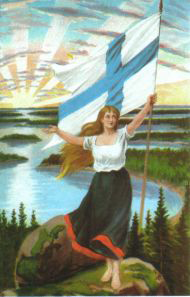 |
The Moomins, from the 1990–91 television animation.
From left to right, Sniff, Moominmamma, Moominpappa,
Moomintroll (Moomin) and Little My. |
It was almost 30 years ago when I first learnt
about a peculiar place called the Moomin Valley. This is an idyllic magical part
of Finland inhabited by the Moomins, white hippopotamus-like creatures created by
Finnish illustrator and writer Tove Jansson in 1945.
Over a period of 70 years,
the Moomin stories have continued to thrill Finns of all ages. Although I didn’t know about the Moomins
before moving to Finland, I got to know all about them through my children, by reading
the books, watching the films and singing the songs.
 |
| A Moomin playhouse |
A land of Moomin-mania
Finland is a land of Moomin-mania where
fact and fiction often merge. A Finn will have no hesitation telling you that the
Moomins live in a pointy blue house with white windows; after all there are numerous
replica Moomin houses used as playhouses found in gardens all over the country.
In Finland, there is even a
Moomin Valley theme park in a place called Naantali, which every Finnish child will
have visited, if they were fortunate enough to have been blessed with good
caring parents. Incidentally, I was not one of those parents! (And my adult kids
are still suffering to this day).
Knowing your stuff!
Besides the Moomins, there are several other creatures in the Moomin
Valley. In this 70th anniversary year, you would be well warned not
to try to come to this country without knowing what these creatures are called
or how they look.
The Moomins and their friends are so close to the Finnish
psyche that everyone needs to be able tell a Hattifatterer from a Fillyjonk. Not
being able to do proves to all concerned that you are either rude or stupid, if
not both.
Everyone has their favourite character
In Finland, everyone has their favourite Moomin Valley character;
for some it might be the philosophical patriarch Moominpappa with his top-hat
or the caring Moominmamma with her stripy apron and magical handbag.
 |
| Stinky on the run |
For others
it might be the timid Sniff, who looks like a Dachshund walking on hind legs (BTW
Sniff is in the very top picture on the left). And for some, the favourite
could be Little My (the small angry one holding a rolling pin).
My hero, however, is definitely
Stinky, a furry wide-eyed black blob, who is often
portrayed running away with drink bottles from parties he hasn't been invited
to.
I like to think that Stinky was the propagator of the modern Finnish beer run.
What
is a Finnish beer run?
A Finnish beer run takes place at any shop or kiosk where beer
is sold. In Finland, beer often comes in packs of six or twelve. A twelve pack
is affectionately known as a Dachshund (Mäyräkoira) due to its shape. My Moomin
character Stinky would have called it a ‘Sniff’ but let’s not bog ourselves
down with details. So a Finnish beer run means grabbing two Dachsunds, one in
each hand, and running as fast as you can out of the shop without paying. Way
to go Stinky!
A time for change
As you probably realise, my friend Stinky has a very bad
reputation in Moomin Valley. The Moomins say he is always trying to cheat
everyone and often gets caught. However, I feel that he is totally
misrepresented and the Moomins themselves must take some responsibility for
that.
So now after 70 years I think it is time to have a little social change
in the Moomin Valley. After all, let’s not forget that the Moomins are the ones
with all the money and the nice big house. What does Stinky have…nothing.
A new social contract
 |
| Moomin Inc. |
Perhaps it is about
time that the Moomins let Stinky in on their lucrative mug factory operation on
the other side of the Moomin Valley. There, the Moomins have successfully been producing
limited edition ceramic Moomin merchandise since the 1950s.
A golden future ahead
The good news
for the Moomins is that there’s no shortage of collectors in Finland queuing up
to buy their products. I am certainly looking forward to seeing Stinky’s rehabilitation into Moomin
society in the future…assuming of course that he would ever actually consider being rehabilitated.
_______________________________________________________________________






















